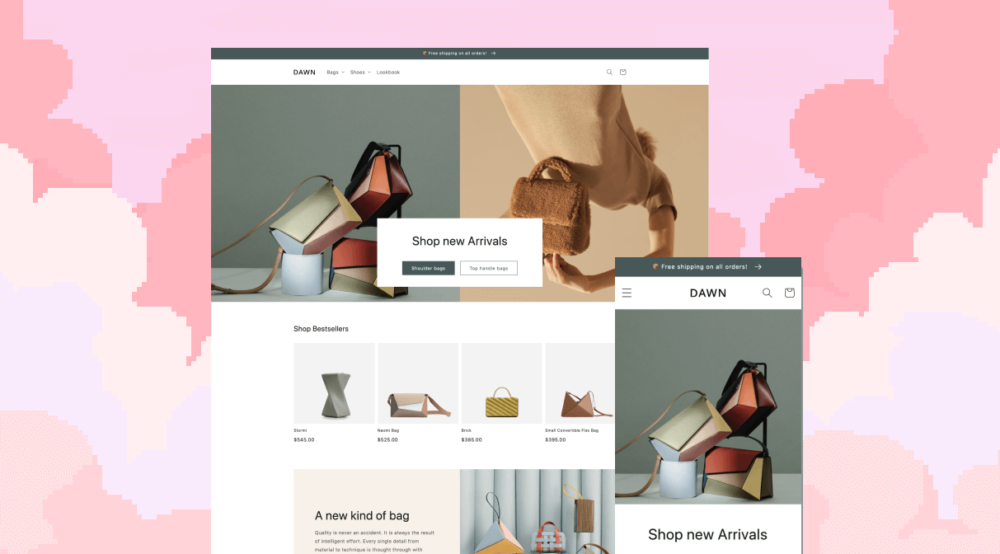About Us
Our team genuinely love design, development and strategy for online success.
Our Services
Our team of experts will guide you through your project using the following services.
It’s been a year now since the announcement of Shopify Online Store 2.0 (OS 2.0) at Unite in June 2021. In this article, we’ll reflect on what it means for merchants looking to cross migrate a website or existing Shopify store to an OS 2.0 theme.
Shopify has built Online Store 2.0 with a new set of tools. It not only provides opportunity and flexibility for developers, it also provides positive experiences for merchants and their customers.
Here are our Shopify Experts’ top 5 reasons to use OS 2.0:
Online Store 2.0 makes it easier, and more flexible for merchants to work within the theme architecture. A key difference is that there are sections on every page. Previously sections were only available on the homepage of a website. This meant that merchants relied heavily on developers to implement a large amount of customisation to replicate the same look and feel across other pages. The sections within OS 2.0 allow developers to add personalisation on each page, including headers, images, and text banners. With an easier use, merchants have more flexibility to update these sections themselves, being more empowered to make changes to their own storefront and ultimately provide their customers with a better user experience.
The new architecture within OS 2.0, provides developers with a more structured process to integrate third-party applications within the storefront. Shopify introduced theme app extensions for developers to help developers integrate apps into merchant storefronts.
On Online Store, the way an app embedded into a storefront was very rigid. Developers had to create a custom integration for each app if the merchant wanted it to appear in a different location. With challenges and little flexibility, it was costing merchants time and money to build logical integrations that were fast, and worked consistently across all of the themes.
The new app extensions use app blocks, making it more efficient and reducing the challenges. The app blocks allow merchants to choose which pages, and where each displays within their store. Another bonus with the new theme is that the app settings can be updated directly through the theme editor!
Metafields are pieces of data that relate to a part of your Shopify store, such as product pages or orders. Before the introduction of Online Store 2.0, Shopify only allowed merchants to add the page title and one single rich text editor for any page, product or collection. This meant that if merchants wanted to add any product specific information such as product specifications or a size chart, they often had to use additional metafield application integrations and often needed a developer to customise the code.
With the release of OS 2.0, comes Shopify’s own metafield functionality, providing brands the chance to showcase more unique information about each of their products in a more seamless way, without the need for an additional app. The metafields also support images which can be used to accompany products and share more information. This new feature means that merchants can make changes themselves within the Shopify store, showcasing detailed information for their customers and saving them time and money on developers.
The first reference theme with OS 2.0 flexibility, Dawn, brings together these new features to provide flexibility and speed while reducing overall complexity. With increasing web standards and UX/UI best practices, Shopify created a new default theme to meet merchants’ news.
Merchants were increasingly wanting to customise the code within their store and Dawn helps to solve this. To provide a positive experience on all browsers, Shopify has built Dawn with semantic markup with HTML and CSS, instead of relying on polyfills and external libraries.
The Core Web Vitals (CVW) are Google’s set of three factors to determine site speed and user experience. These measurements influence a site’s seo ranking and on-site customer experience. Online Store 2.0 has a focus on speed, and therefore sites that are migrating to an OS 2.0, are seeing positive increases in their CWV results. Read how our client Hammer Hardware saw phenomenal results on a new theme.
The new default theme brings together all the new features, including speed. Dawn loads 35% faster than Debut, the previous default theme which over 50% of Shopify merchants are currently using. Find out more about Dawn here.

Shopify has invested in the way developers can code and build Shopify stores with the new Online Store 2.0 themes. Liquid is Shopify’s own code language, allowing developers to create structure and functionality within an online store. OS 2.0 has made some improvements with the following tools;
Overall migrating to Online Store 2.0 means a faster, more flexible store for merchants and less reliance on developers and bespoke changes. OS 2.0 also future-proofs a merchant’s store, as non-OS 2.0 features will eventually become outdated. Both new and existing Shopify merchants should consider cross migrating their store onto OS 2.0 to leverage these benefits.